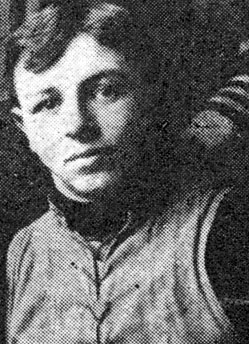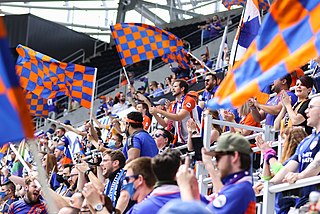Related Research Articles
The Akron Pros were a professional football team that played in Akron, Ohio from 1908 to 1926. The team originated in 1908 as a semi-pro team named the Akron Indians, but later became Akron Pros in 1920 as the team set out to become a charter member of the American Professional Football Association. Fritz Pollard, the first black head coach in the NFL, co-coached the Akron Pros in 1921. Paul Robeson played for the team in 1921 as well. He was among the earliest stars of professional football before football became segregated from 1934 to 1946. In 1926, the name was changed back to the Akron Indians, after the earlier semi-pro team. Due to financial problems, the team suspended operations in 1927 and surrendered its franchise the following year.
The Cleveland Tigers were the first Cleveland team franchise in what became the National Football League (NFL). The Tigers played in the "Ohio League" before joining the American Professional Football Association during the 1920 and 1921 seasons.

Martin Francis Hogan, nicknamed "The Indianapolis Ringer", was an English born right fielder in Major League Baseball who played for the Cincinnati Reds (1894) and St. Louis Browns (1894–1895). After leaving the National League, Hogan moved on to the minor league Indianapolis Hoosiers. Some sources suggest he set a national baserunning record in the 1890s.
The Ohio–Pennsylvania League (1905–1912) was a Class C and Class D level minor league baseball league that featured franchises based in Ohio, Pennsylvania, and West Virginia. The league was founded by Charlie Morton and operated for eight seasons, with the Akron Champs winning four league championships.

The Youngstown Ohio Works baseball team was a minor league club that was known for winning the premier championship of the Ohio–Pennsylvania League in 1905, and for launching the professional career of pitcher Roy Castleton a year later. A training ground for several players and officials who later established careers in Major League Baseball, the team proved a formidable regional competitor and also won the 1906 league championship.
The Interstate League was the name of five different American minor baseball leagues that played intermittently from 1896 through 1952.

The Youngstown Patricians were a semi-professional football team based in Youngstown, Ohio. In the 1910s, the team briefly held the professional football championship and established itself as a fierce rival of more experienced clubs around the country, some of which later formed the core of the National Football League. The Patricians football team motto was "With Malice to None and a Square Deal to all."
The Youngstown Indians were a Minor League Baseball club that competed during the 1909 season in the Ohio–Pennsylvania League. The team showed great promise at the outset of the season but finished with a disappointing 46–78 record, placing last in the league. The league championship that year went to an Akron franchise, which closed the season with an 81–40 record.
The Youngstown Champs were a minor league baseball team that competed in the Ohio–Pennsylvania League in 1907 and 1908. The club won the league championship in 1907 but disbanded in the middle of the 1908 season.
Walter Rufus East was a minor league baseball player active between 1903 and 1912. As a second baseman he played for various in the Southern Association, Eastern League, Missouri Valley League, Ohio State League and the Ohio–Pennsylvania League. East however also managed several minor league teams from the Ohio–Pennsylvania League.
Homer Hurd Davidson was a professional Major League Baseball player for the Cleveland Naps. Born in Cleveland, Ohio, he played only 6 games for the Naps during the 1908 season. Davidson was better known as a professional football player. He played in the Ohio League, which was the direct predecessor to the modern National Football League. One veteran Ohio sportswriter once rated Davidson to be the equal of Walter Eckersall, an infamous quarterback from the University of Chicago. He attended college at the University of Pennsylvania and played on the Penn Quakers baseball team.
The Central League was a minor league baseball league that operated sporadically from 1903–1917, 1920–1922, 1926, 1928–1930, 1934, and 1948–1951. In 1926, the league merged mid-season with the Michigan State League and played under that name for the remainder of the season. The Central League later reformed in 1928.
The Canton Bulldogs–Massillon Tigers betting scandal was the first major scandal in professional football in the United States. It refers to a series of allegations made by a Massillon, Ohio newspaper charging the Canton Bulldogs coach, Blondy Wallace, and Massillon Tigers end, Walter East, of conspiring to fix a two-game series between the two clubs. One account of the scandal called for Canton to win the first game and Massillon was to win the second, forcing a third game—with the biggest gate—to be played legitimately, with the 1906 Ohio League championship at stake. Another account accused Wallace and East of bribing Massillon players to throw a game in the series. Canton denied the charges, maintaining that Massillon only wanted to damage the club's reputation. Although Massillon could not prove that Canton had indeed thrown the second game and it remains unknown if there was ever a match-fixing agreement, the scandal tarnished the Bulldogs name and reportedly helped ruin professional football in Ohio until the mid-1910s.
The Massillon Tigers were an early professional football team from Massillon, Ohio. Playing in the "Ohio League", the team was a rival to the pre-National Football League version of the Canton Bulldogs. The Tigers won Ohio League championships in 1903, 1904, 1905, and 1906, then merged to become "All-Massillons" to win another title in 1907. The team returned as the Tigers in 1915 but, with the reemergence of the Bulldogs, only won one more Ohio League title. Pro football was popularized in Ohio when the amateur Massillon Tigers hired four Pittsburgh pros to play in the season-ending game against Akron. At the same time, pro football declined in the Pittsburgh area, and the emphasis on the pro game moved west from Pennsylvania to Ohio.
Jack Cusack was one of the prominent early figures in professional football in Ohio. At the age of twenty-one, Cusack became the manager and owner of the Canton Bulldogs, one of the leading teams of the day. During his six years with the Canton Bulldogs, Cusack led the team to Ohio League championships, in 1916 and 1917, and was responsible for bringing Jim Thorpe into professional football. Cusack also is responsible for helping revive the Bulldogs following the Canton Bulldogs-Massillon Tigers Betting Scandal, which eroded public support for the game from 1906 until 1911. He also ensured that the Bulldogs had a sturdy financial foundation for when they would later enter the National Football League (NFL). In 1918, Cusack left football to enter the oil and gasoline business in Oklahoma. He later worked as an independent oil operator in Fort Worth, Texas.

George Watson "Peggy" Parratt was a professional football player who played in the "Ohio League" prior to it becoming a part of the National Football League (NFL). Born in Cleveland, Ohio, Parratt played quarterback for the Shelby Blues, Lorain Pros, Massillon Tigers, Massillon All-Stars, Franklin Athletic Club of Cleveland, Akron Indians and the Cleveland Tigers between 1905 and 1916. Parratt threw the first legal forward pass in professional football history while playing for the Massillon Tigers on October 25, 1906.
The Union Club of Phoenixville was a professional football team based in Phoenixville, Pennsylvania. The team was the result of a 1919 merger between the Phoenixville Union Club and the upstart Phoenix Athletic Club. From 1907 until 1919, the Union Club was considered one of the best football teams in eastern Pennsylvania. However, in 1919 the upstart Phoenix Athletic Club signed many of the top players of the area, leaving the Union Club no choice but to merge with the Phoenix A.C. The team is best known for defeating the Canton Bulldogs 13–7, in 1920. The team folded in 1921.
Sherburne Henry Wightman was a professional American football player-coach in the "Ohio League", which was the direct predecessor to the modern National Football League (NFL). He is best remembered for coaching the Massillon Tigers to an Ohio League title in 1906, over the Canton Bulldogs, which led to accusations of a betting scandal. In 1907, he coached a version of the Massillon Tigers called the "All-Massillons" to another Ohio League title. Prior to his professional career, Wightman played at the college level for the Chicago Maroons, under Amos Alonzo Stagg, and Swarthmore College.

Ohio is home to many professional and college sports teams. The metropolitan areas of Cleveland, Cincinnati, and Columbus are home to major league professional sports teams in baseball, basketball, football, hockey, and soccer.
The Canton Bulldogs were a professional American football team, based in Canton, Ohio. They played in the Ohio League from 1903 to 1906 and 1911 to 1919, and the American Professional Football Association, from 1920 to 1923, and again from 1925 to 1926. The Bulldogs won the 1916, 1917, and 1919 Ohio League championships. They were the NFL champions in 1922 and 1923. In 1921–1923, the Bulldogs played 25 straight games without a defeat. This remains an NFL record.
References
- ↑ "Akron, Ohio Encyclopedia". Baseball-Reference.com. Retrieved 2023-02-22.
- ↑ "Akron Champs minor league baseball Statistics and Roster on StatsCrew.com". www.statscrew.com. Retrieved 2023-02-22.
- Baseball Reference Akron, Ohio
- Baseball Team Names, 1869–2012. McFarland Publishing (2012)
- Sandoval, Jim; Nowlan, Bill. Can He Play? A Look at Baseball Scouts and Their Profession. SABR, Inc. ISBN 978-1-933599-23-6.
- "Blondy Wallace and the Biggest Football Scandal Ever" (PDF). PFRA Annual. Professional Football Researchers Association. 5: 1–16. 1984. Archived from the original (PDF) on 2010-12-18.